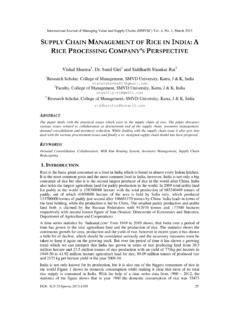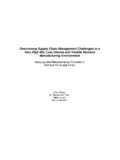Transcription of SUPPLY CHAIN MANAGEMENT IN INDIAN …
1 International Journal of Managing Value and SUPPLY Chains (IJMVSC) , No. 2, June 2014. SUPPLY CHAIN MANAGEMENT IN INDIAN . AUTOMOTIVE INDUSTRY : COMPLEXITIES, CHALLENGES AND WAY AHEAD. Souresh Bhattacharya1, Dr. D. Mukhopadhyay2 and Dr. Sunil Giri3. 1. Research Scholar, College of MANAGEMENT , SMVD University, Katra, J & K, India 2. Dean, Faculty of MANAGEMENT , SMVD University, Katra, J & K, India 3. Associate Professor, MDI, Murshidabad, West Bengal, India ABSTRACT. The INDIAN automotive industry, comprising vehicle and component manufacturers, has grown steadily since the economic liberalization of the early 1990's. The arrival of major global auto companies has galvanised the domestic sector into adopting SUPPLY CHAIN best practices.
2 This has enhanced competitiveness leading to a quantum growth in exports. However, the INDIAN automotive industry has to operate in an unique environment further posing challenges to the already complex automobile SUPPLY CHAIN . Therefore, a need is felt to continually study SUPPLY CHAIN practices in this sector from a contemporary, practitioner's viewpoint in order to identify key factors of differentiation which would ultimately provide competitive advantage. This paper seeks to understand the present status, complexities and challenges facing the INDIAN automobile sector. It examines trends such as visibility and innovation, collaboration and SUPPLY networks and evolving leadership roles impacting SUPPLY CHAIN effectiveness.
3 Strategies for overcoming challenges are presented as also a framework for further study and analysis. KEYWORDS. SUPPLY CHAIN MANAGEMENT , automotive industry, SUPPLY CHAIN Challenges, Assembler-supplier synergy, India 1. INTRODUCTION. Universally, the automotive industry has been accepted as a major driver of growth of a nation's economy and is a significant contributor to the global economy. The automobile has been described as both a form and function' based product involving high level of engineering as well as being positioned as a fashion product [1]. The industry has rightly been called as the industry of industries , since it uses outputs of nearly all manufacturing industries [2] and supports upstream (mining, steel etc) and downstream industries (finance, insurance, after.)
4 Market etc) [3]. Infusion of technology has led to incorporation of electronics (sensors, actuators) replacing mechanical design of assemblies engine brake system, steering etc, built in test equipment, entertainment and navigation system and advancements in materials and design [4][5]. India, China and Brazil are major emerging markets with robust domestic demand and adequate local production [6][7]. Global automotive companies have lowest EBIT margins in comparison to industry leaders ( ) but having the highest number of inventory turns ( ). and best in class delivery performance ( ) [8]. The industry is asset, material and labour intensive which calls for involved operational planning and execution at all levels of MANAGEMENT .
5 Government interventions have been a major driving force for development of the automobile industry in Brazil, China, South Korea and the United States at the Incubation, Penetration and Sustainability stages [3]. DOI: 49. International Journal of Managing Value and SUPPLY Chains (IJMVSC) , No. 2, June 2014. However, sub-optimal usage of SUPPLY CHAIN MANAGEMENT practices pose challenges to automakers in their quest for achieving competitive advantage, especially in emerging markets like India. Therefore there is a need to examine various aspects of automobile SUPPLY chains in an emerging market which has its own peculiarities. It is in this context that discussions in this paper seek to bring out challenges and complexities in automobile SUPPLY chains, presenting emerging trends from the global automotive industry and its applicability in INDIAN context.
6 Significant issues that impact design and practices, from a futuristic viewpoint, are covered and a framework presented, concluding with suggestions for future research. This paper is exploratory in form and based on a study of contemporary published literature (including research papers, studies and surveys by reputed consulting companies and respective Governmental agencies) and secondary data. There are two major differentiating aspects of this paper, firstly, that it takes a practitioner's viewpoint in the discussions on major SUPPLY CHAIN issues and, secondly, the suggestions and determinants for attaining competitive advantage are based on a futuristic perspective obtained by a wide scan of global SUPPLY CHAIN practices.
7 Section 2 highlights the characteristics of the INDIAN automotive industry. Section 3 covers major issues in contemporary automotive SUPPLY chains integration, challenges, OEM-Supplier synergy, leveraging technology and visibility and performance measurement. Section 4. enumerates some strategies to overcome challenges and presents a framework keeping in perspective emerging and futuristic trends from the global arena. Suggested directions for future research are enumerated in Section 5. INDUSTRY IN INDIA: PRESENT SCENARIO. Although the INDIAN automotive industry has its genesis in the 40's, it has seen considerable growth in the last two decades mainly due to economic liberalization including 100% FDI in the sector [9].
8 Global auto and component manufacturing companies are motivated to establish manufacturing and R&D facilities in the country due to availability of large pool of skilled workers, low production costs, faster design and development process and emerging market status These companies outsource most functions regionally retaining control on product development and strategic procurement [10][11]. The industry comprises various groups . assemblers, multi-national assemblers, INDIAN component suppliers, multi-national component suppliers, each with specific strengths and weaknesses [12], with 77% of the production value contributable to the organized sector and the rest in SME sector [7].
9 Presently, there are more than 30 OEMs offering more than 75 options in all categories of vehicles. India's automotive industry is the world's sixth largest producer of automobiles in terms of volume and value and has grown in the last decade. The industry contributes 7% to India's GDP, 7-8% of the total employed population (about 13 million people), 4% of exports [13] [14], 39% of FDI. inflows (USD billion between 2009-13) and contributes 17% to total indirect taxes collected. Overall domestic sales are led by two-wheelers, ( of total sales in 2012-13) followed by passenger vehicles ( ) and commercial vehicles ( ) [14]. In the last five years there has been an overall growth in automobile production (from million vehicles in 2007-8 to million vehicles in 2012-13).
10 Although 2012-13 has seen almost stagnant sales, exports have increased by 10% in the same period. However, in global terms, even with export earnings of 4 billion USD ( including billion USD as exports of auto component sector), the automotive sector contributes only of world production and is ranked a low 26th in rank in the world auto export market with a share of The quest of INDIAN automotive industry in striving for global competitiveness is evident from the fact that major automotive manufacturers are the second-largest number of recipients (after Japan) of the Deming award for quality. Significantly, India has the best-in-class fuel economy rates as well as affordable total cost of ownership [15] [16].










